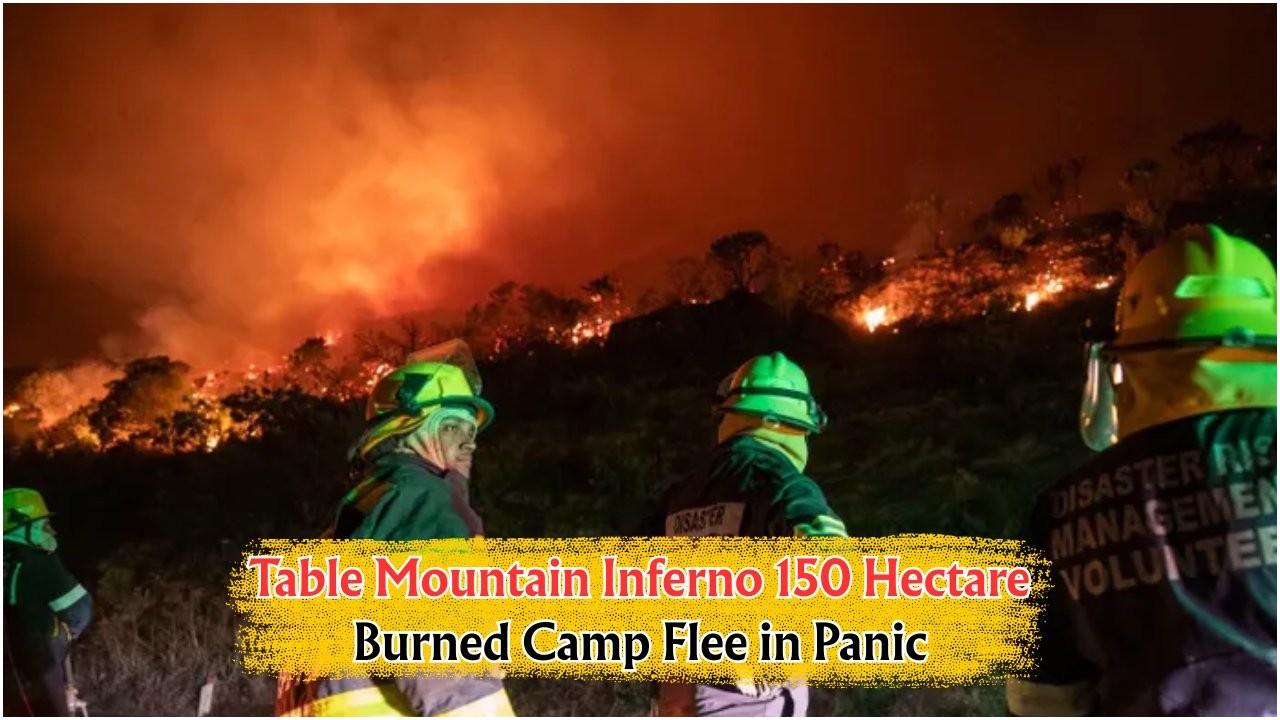Table Mountain Wildfire Triggers Mass Evacuation: In early July, a devastating wildfire ravaged the iconic Table Mountain, consuming a staggering 150 hectares of its lush landscape. The blaze, fueled by dry conditions and strong winds, forced authorities to initiate a mass evacuation of nearby residents. With Cape Town’s fire services on high alert, the community watched in disbelief as the flames charred the beloved natural landmark, bringing to light the vulnerabilities of living in the shadow of such a majestic yet unpredictable force of nature.
Impact of the Wildfire on Table Mountain’s Ecosystem
The Table Mountain wildfire’s impact on the local ecosystem has been profound. Known for its rich biodiversity, the mountain is home to a variety of endemic flora and fauna. The fire, however, destroyed critical habitats and threatened several rare species. Conservationists are particularly concerned about the loss of fynbos, a unique vegetation type that is crucial for maintaining the ecological balance. Additionally, the fire has disrupted the natural water cycle, affecting the mountain’s ability to retain moisture and potentially altering its landscape for years to come.
- Destruction of fynbos vegetation
- Threat to endemic species
- Altered water retention capabilities
- Loss of habitats
- Potential for soil erosion
- Disruption of ecological balance
- Impact on local climate patterns
- Long-term recovery challenges
Emergency Response to the Table Mountain Wildfire
The response to the wildfire was swift and coordinated, with multiple agencies working together to contain the blaze. Cape Town’s fire department, supported by aerial resources and ground crews, battled the flames tirelessly. The swift evacuation of residents was paramount to ensure safety, and shelters were set up to accommodate those displaced by the fire. Volunteers and community organizations also played a crucial role in providing support and resources to those affected.
- Deployment of aerial firefighting resources
- Coordination among local and national agencies
- Establishment of emergency shelters
- Community and volunteer support
- Efforts to safeguard wildlife
- Utilization of technology for fire tracking
- Public safety advisories and updates
Long-term Effects on Cape Town’s Community
The aftermath of the wildfire has left a lasting impact on the Cape Town community. Residents are now grappling with the physical and emotional toll of the disaster. The loss of natural beauty and recreational spaces has been deeply felt, and the economic consequences are beginning to surface. Tourism, a significant contributor to the local economy, has seen a downturn as visitors express concerns about safety and accessibility. Moreover, the psychological impact on residents, particularly those who were evacuated or lost property, continues to be a focus for local support services.
Community Recovery Efforts
- Local business support initiatives
- Rebuilding and restoration projects
- Focus on mental health services
- Encouraging tourism through safety reassurances
- Long-term environmental monitoring
- Education on fire prevention
- Community resilience programs
Wildfire Prevention and Preparedness in South Africa
In response to the Table Mountain wildfire, authorities are emphasizing the importance of wildfire prevention and preparedness. Educational campaigns are being launched to inform the public about fire safety measures and the role of climate change in increasing fire risks. Local governments are also investing in better infrastructure and technology to detect and respond to fires more efficiently. These efforts aim to mitigate the impact of future wildfires and ensure the safety of both residents and the environment.
- Public education campaigns
- Investment in firefighting technology
- Development of early warning systems
- Community engagement in fire prevention
- Research on climate change impacts
- Improved communication strategies
- Strengthening emergency response infrastructure
Community Involvement in Fire Safety
Community involvement is a crucial aspect of fire safety and prevention. Residents are encouraged to participate in local fire awareness programs and to maintain fire-safe properties. By fostering a culture of vigilance and preparedness, communities can better protect themselves and their natural surroundings from the devastating effects of wildfires.
| Fire Safety Tips | Actions |
|---|---|
| Maintain clear vegetation | Remove dry brush and overgrown plants |
| Install firebreaks | Create defensible spaces around properties |
| Stay informed | Monitor local news and weather updates |
| Have an evacuation plan | Know escape routes and emergency contacts |
| Support local initiatives | Participate in community fire drills |
| Report suspicious activity | Alert authorities to potential fire hazards |
Role of Technology in Managing Wildfires
As wildfires become more frequent and severe, technology plays an increasingly vital role in managing these natural disasters. From advanced fire detection systems to drones providing real-time data, technological innovations are revolutionizing how fires are fought. These tools not only enhance the efficiency of firefighting efforts but also help in predicting and preventing future incidents.
Innovative Firefighting Technologies
 Budget 2025 Stealth Tax Alert: While VAT Freezes, Hidden Increases Strike Food, Fuel & Sin Goods
Budget 2025 Stealth Tax Alert: While VAT Freezes, Hidden Increases Strike Food, Fuel & Sin Goods
- Satellite imagery for fire monitoring
- Drone surveillance for real-time updates
- Artificial intelligence for predictive analysis
- Thermal cameras for hotspot detection
- Mobile apps for public alerts and information
- GIS mapping for resource allocation
- Smart sensors for early fire detection
Table Mountain Wildfire: Lessons Learned
The Table Mountain wildfire has served as a sobering reminder of the challenges posed by climate change and the importance of proactive measures. As South Africa reflects on this event, there is a renewed commitment to safeguarding its natural treasures and protecting communities from similar disasters in the future.
| Lessons Learned | Implementation |
|---|---|
| Strengthen community resilience | Engage local stakeholders in planning |
| Enhance fire detection capabilities | Invest in advanced technology |
| Promote sustainable land management | Encourage eco-friendly practices |
| Increase public awareness | Conduct regular educational campaigns |
| Improve emergency response | Streamline coordination among agencies |
The wildfire has highlighted the need for ongoing vigilance and adaptation in the face of environmental changes. By learning from past experiences and leveraging new technologies, South Africa can better prepare for and respond to the challenges posed by wildfires. Through concerted efforts and community involvement, the nation aims to reduce future risks and safeguard its cherished landscapes.
FAQ on Table Mountain Wildfire
What caused the Table Mountain wildfire?
The fire was primarily fueled by dry conditions and strong winds, although the exact cause is still under investigation.
How many hectares were affected?
The wildfire consumed approximately 150 hectares of land.
Were there any casualties?
No casualties were reported, but several residents were evacuated as a precautionary measure.
What is being done to prevent future wildfires?
Authorities are enhancing fire prevention measures, including public education and investment in technology.
How can residents help in fire prevention?
Residents can participate in community programs, maintain fire-safe properties, and stay informed about fire safety guidelines.









